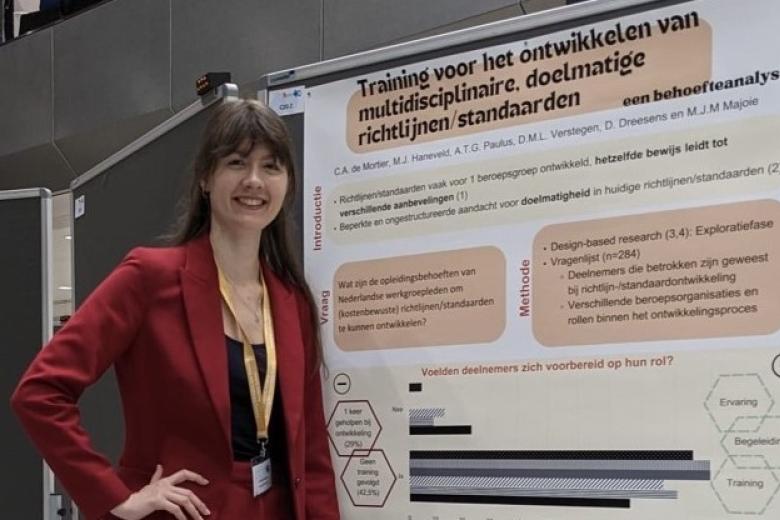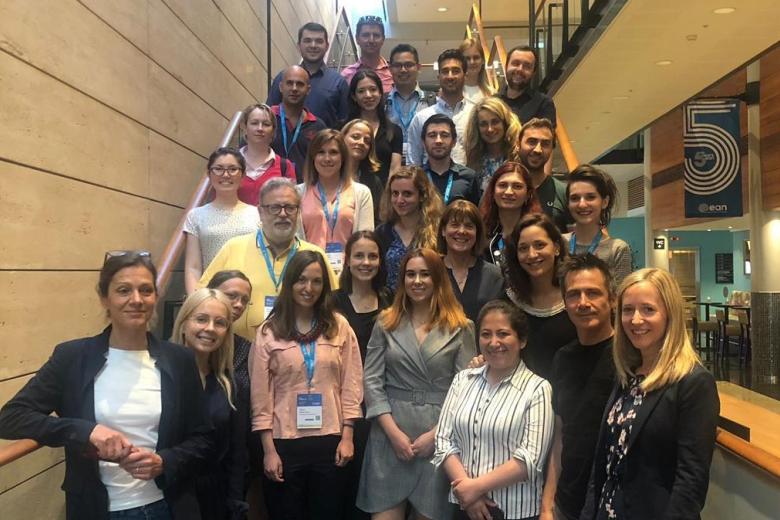Cost-Conscious Healthcare - CoCoCare
A ZonMw grant in 2021, launched the project "Learning platform for guideline development: future-proof and sustainable". This 4 years project develops a learning platform that can support and further standardize clinical guideline (developments) in different (para)medical fields, while also including cost-conscious care. The project is a joint effort of the Maastricht School of Health Professions Education (SHE) and the Care and Public Health Research Institute (CAPHRI), research line Creating Value-Based Health Care and the Academic Center of Epileptology Kempenhaeghe Maastricht UMC; in close collaboration with the Knowledge Institute of the Dutch Association of Medical Specialists (KIMS).
With the growing medical possibilities, new questions arise. It is not only a matter of being able to treat, but also of considering the added value of treatment. In deciding the value of treatment, many factors have to be weighed, such as health benefit, quality of life effect and expenses. Medical guidelines can make an important contribution when making such treatment decisions. As such, they have a considerable influence on the quality and effectiveness of healthcare and allow the (future) healthcare professional to be as cost-conscious as possible.
Introduction
Project description
In the Netherlands, health care expenditure is the largest cost item in the national budget; these will increase if policy remains unchanged. (Para)medical guidelines are intended to guide various, often multidisciplinary, decision-making processes and to enable treatment teams to find a balance between quality, effectiveness and costs. Despite the major effect these guidelines have on the behavior of healthcare professionals, we rarely see their development, application and implementation addressed in (para)medical training programs or education.
Target
The aim of this learning platform is to bring about behavioral change in healthcare professionals from a social and patient/care provider perspective.
Method
We do this by optimizing guideline training, creating a community and e-learning platform, developing guideline test cases and – for further development of the training – evaluation through design-oriented research.

In this Dutch podcast of Prof.dr. Marian Majoie talks about the importance of High Value Cost Conscious Care and how the CoCoCare training program contributes to this.
Research
Chloé de Mortier
Hi, I am Chloé, and for the past almost two years, I have been immersed in my PhD research. What is the focus of my research, you ask? Well, I'm delving deep into the world of clinical practice guideline development training, with a keen eye on keeping healthcare costs in check.

Jen Yaros
Profound changes in the healthcare system and a growing, global shortage of healthcare workers are driving the demand to update and scale-up health professional education. However, due to rising costs and falling budgets, institutes of health professions education (HPE) are operating in a deepening environment of resource scarcity. These concurrent conditions have sparked interest in utilizing cost-effectiveness analysis to guide resource allocation decisions in HPE.

Danielle Versteegen
The second half of 2022 gave opportunities to give attention to Cost-Conscious Healthcare in different communities. At the AMEE 2022 (https://amee.org/conferences/amee-2022) we presented our experiences with the CoCoCare training for European residents in Neurology to a public of teachers and researchers in health professions education (Majoie, Verstegen, Evers & van Maastrigt: European Guideline Education and Cost-Conscious Care) .

Publications
- Yaros J. A call to unify cost and economic impact research of health professions education. Med Educ. 2025; 59(4): 354-356. doi:10.1111/medu.15590
- Yaros J, de Mortier C, Oude Egbrink M, Evers S, Paulus A. Cost Identification in Health Professions Education: A Scoping Review. Med Educ. 2024; 58(8): 920-929. https://doi.org/10.1111/medu.15393
Presentations
Presentations soon to be added
Training
EAN - European Academy of Neurology
- Prof. dr. Marian Majoie explains in a short film the training program>
- To the EAN CoCoCare training program>
- To the presentation on Training in guideline development>

Samen richtlijnen ontwikkelen met een actieve community
Hoe kun je als beroepsgroepen meer samenwerken bij het ontwikkelen van onderbouwde richtlijnen voor goede zorg? En hoe zorg je ervoor dat zorgprofessionals kennis hebben van deze richtlijnen en ze toepassen in de praktijk?
Neuroloog en hoogleraar Marian Majoie en senior beleidsmedewerker Klaartje Spijkers vertellen over het project om een community en leerplatform voor richtlijnontwikkeling te creëren. Daarmee willen zij uiteindelijk bijdragen aan samen beslissen, een betere behandeluitkomst voor de patiënt en lagere zorguitgaven.

Posters
Guideline development: Percutaneous Endoscopic gastrostomy in advance dementia patients
Colonna I., Carvalho V.
To the poster >
Research question: In patients with dementia, does percutaneous endoscopic gastrostomy, when compared to oral feeding, reduces mortality?
Guideline: use of cholinesterase inhibitors and memantine in vascular dementia
Cabreira V., Massano J.
Research question: Our PICO question was whether ChEI or memantine rather than standard of care (no pharmacological treatment) should be used in patients with vascular dementia to improve important clinically meaningful outcomes such as cognitive functioning, global clinical impression, behaviour and performance of ADL.
The guideline developers prioritised this question.
Perspective: Population.
Guideline development followed the Grading of Recommendations Assessment, Development and Evaluation (GRADE) Working Group. Several outcomes were identified and judgements were made in relation to its importance. Overall, outcomes for cognitive functioning, ADL and global clinical impression were considered to be of critical importance (rating 7-9) while outcomes for behaviour were classified as important (mean rating of 6). Outcomes related to adverse events were also rated and globally were considered to be important, while number of deaths was classified as a critical outcome.
Rituximab and Cyclophosphamide as Second-line Immunotherapy for Autoimmune Encephalitis
Antonia Lefter, Liviu Cozma, Bogdan Ovidiu Popescu
The PICO question was the following:
For adult patients (at least 18 years old) with Autoimmune encephalitis (AE), does treatment with rituximab (375 mg/ once a week for at least 4 weeks or 1 g infused twice, 2 weeks apart), cyclophosphamide (750 mg/ once a month for at least 4 months), or both regimens combined, as opposed to absence of intervention, lead to a better clinical outcome (decrease in the mRS of at least 1 point from onset), or absence of relapses, i.e. exacerbation of previous symptoms or the occurrence of new symptoms.
Guideline: use of pharmacological therapy in the treatment of diabetic peripheral neuropathic pain
Nadezhda Ruzhdii
PICO question: wheather pregabalin or gabapentin or duloxetine should be used as first-line treatment instead of standard of treatment (amitriptilin) of diabetic peripheral neuropathic pain.Population: diabetic peripheral neuropatic pain individuals 2) Intervention: pregabalin or gabapentin or duloxetine treatment or standart AMT treatment ; 3) Setting: all countries; 4) Outcome: reduced neuropatic pain. Side symptoms reported in the studies: diarrhoea, dizziness, headache, somnolence and nausea considered as adverse events (AE). Outcomes related to adverse events were rated and considered to be important. Number of deaths was classified as a critical outcome. Guideline development followed the Grading of Recommendations Assessment, Development and Evaluation (GRADE) Working Group recommendations in population perspective.
Neuromodulation versus standard care for migraine prophylaxis
Federico Emanuele Pozzi, Nina Vashchenko
PICO question: should neuromodulation be used in patients with migraine for prophylactic therapy?
Through a Delphi procedure, we agreed on a set of 6 outcomes for our search, 3 of which were rated critical (days without migraine, intensity of migraine and acute drugs intake) and 3 important (side effects, functional disability and patients’ satisfaction). Guideline development was carried through according to the Grading of Recommendations Assessment, Development and Evaluation (GRADE) methodology.
-
Incremental cost-effectiveness ratios for Parkinson’s disease patients comparing advanced therapies to best medical treatment
-
Guideline development: Percutaneous Endoscopic gastrostomy in advance dementia patients
-
Guideline: use of cholinesterase inhibitors and memantine in vascular dementia
-
Rituximab and Cyclophosphamide as Second-line Immunotherapy for Autoimmune Encephalitis
-
Guideline: use of pharmacological therapy in the treatment of diabetic peripheral neuropathic pain
-
Neuromodulation versus standard care for migraine prophylaxis